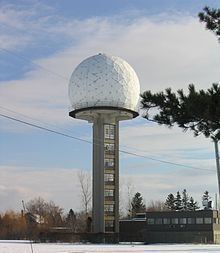 | ||
The J.S. Marshall Radar Observatory (or MRO) is a McGill University facility in Sainte-Anne-de-Bellevue, Quebec, Canada housing several weather radars and other meteorological sensors, many of them running around the clock. It is one of the components of the McGill Atmospheric and Oceanic Sciences department where students in remote sensing perform their research. Furthermore, the main radar is part of the Canadian weather radar network, on a contract with the Meteorological Service of Canada, as well as a research device.
Contents
Purpose
The main focus of the MRO is teaching and research. The group upgrades and designs radars, develops new ways to process the radar signals and use the resulting data, and performs research on the physics of weather events and their prediction. Results of the research are published in scientific journals and transferred for use by the weather office.
History
In 1862, a first Weather Observatory was built by McGill University. The instruments were donated by Dr. Charles Smallwood (MD), who had personally taken weather data with them since 1840. This station became one of the first in the weather station network set up after the telegraph became ubiquitous.
In 1943, "Project Stormy Weather" was assigned to J.S. Marshall by the Department of National Defence. The aim was to find a use for noise in radar echoes that had proved to be from weather. Marshall and his doctoral student Walter Palmer later received recognition for their work on the drop size distribution in mid-latitude rain that led to the rain rate relation to radar reflectivity (Z-R relation). Following World War II, Marshall and R.H. Douglas formed the "Stormy Weather Group" at McGill University and continued their work.
Different radars were used by the Stormy Weather Group to research the characteristics of precipitation at Dawson College, continuing the tradition of meteorology at McGill. It was decided to build a new facility in 1968 in Sainte-Anne-de-Bellevue, on the western tip of Montreal Island and to transfer research activity from Dawson College to this facility. This new observatory was later renamed the J.S. Marshall Radar Observatory in honor of its founder.
Main instrument
A 10 cm wavelength Doppler and dual-polarization radar built in 1968 and used for weather surveillance around the Montreal, Quebec area. It is part of the Canadian weather radar network, used by the local weather office to monitor weather in real time for a variety of applications, from severe weather detection to sewer flow forecasting.
Characteristics:
As it is a research as well as an operational radar, the large amount of data accumulated is studied for further development in radar hardware and software capabilities. The data are correlated with the other instruments in related research.
Other instruments
Many other devices are operated by the MRO at the site or in other locations. These varies according to the research interests pursued. Some of them are or have been:
